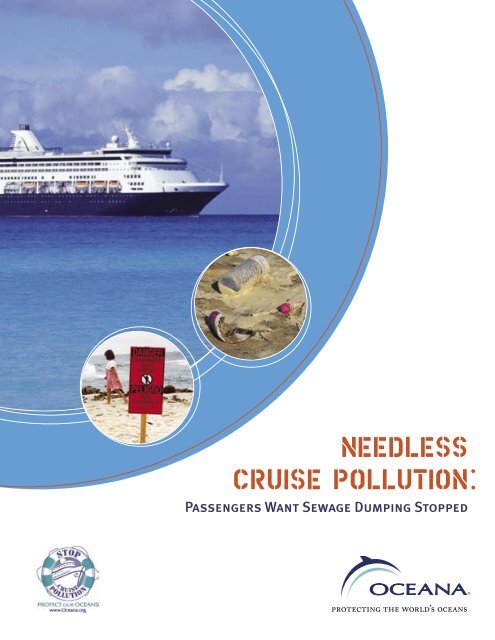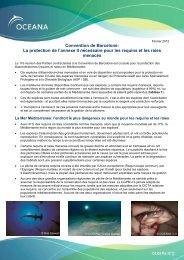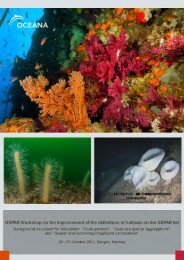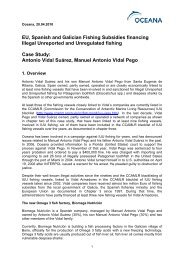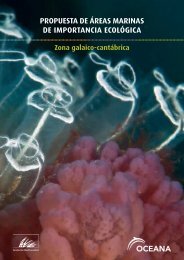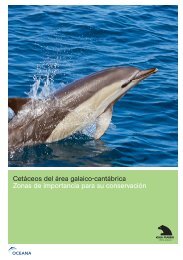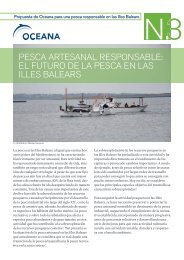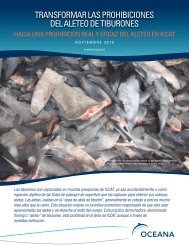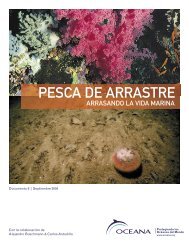Needless Cruise Pollution: Passengers Want Sewage - Oceana
Needless Cruise Pollution: Passengers Want Sewage - Oceana
Needless Cruise Pollution: Passengers Want Sewage - Oceana
Create successful ePaper yourself
Turn your PDF publications into a flip-book with our unique Google optimized e-Paper software.
needless<br />
:<br />
cruise pollution<br />
<strong>Passengers</strong> <strong>Want</strong> <strong>Sewage</strong> Dumping Stopped<br />
protecting the world’s oceans
<strong>Oceana</strong> is a non-profit international advocacy organization<br />
dedicated to protecting and restoring the world’s oceans<br />
through policy advocacy, science, law and public education.<br />
Founded in 2001, <strong>Oceana</strong>’s constituency includes members<br />
and activists from more than 190 countries and territories<br />
who are committed to saving the world’s marine environment.<br />
In 2002, the American Oceans Campaign became part of<br />
<strong>Oceana</strong>’s international effort to protect ocean eco-systems<br />
and sustain the circle of life. <strong>Oceana</strong>, headquartered in<br />
Washington, D.C., has additional offices in key U.S. coastal<br />
areas and will open offices in Latin America and Europe<br />
in 2003. For more information, please visit www.oceana.org<br />
or www.stopcruisepollution.org.
Executive Summary<br />
While thousands of gallons of crude oil from the sunken<br />
tanker, Prestige, are still washing up on European beaches<br />
killing countless fish, mammals and birds, a more insidious<br />
threat placidly sails the ocean in plain sight – cruise ships.<br />
When you see the gleaming white boats on television<br />
commercials, you would never think that those same ships are<br />
a major and growing source of ocean pollution. These floating<br />
vacation resorts, like cities, are literally producing thousands<br />
of gallons of pollutants and tons of solid waste on each ship<br />
every day. Unlike cities, however, cruise ships are exempt from<br />
the discharge permitting program of the nation’s preeminent<br />
water pollution control law, the Clean Water Act.<br />
> <strong>Cruise</strong> ships are needlessly dumping vast amounts of<br />
raw sewage and other harmful wastes into some of the most<br />
pristine parts of our oceans every day. Each day a cruise ship<br />
generates as much as:<br />
• 30,000 gallons of sewage, also called “black water;”<br />
• 255,000 gallons of dirty water from shower, sinks,<br />
laundries and dishwashers, also called “gray water,” which<br />
can contain raw sewage and toxic chemicals from photo<br />
processing, dry cleaning and industrial cleaning products;<br />
• 7,000 gallons of oily bilge water; and<br />
• smokestack and exhaust emissions equivalent to<br />
12,000 cars.<br />
Every day a cruise ship operates, it produces 30,000 gallons of<br />
sewage and is allowed to dump treated sewage anywhere in the<br />
ocean, except in Alaska where the laws prevent such actions.<br />
It is also legal for the cruise industry to dump raw, untreated<br />
sewage in the ocean once a ship is more than three miles from<br />
the U.S. shore. This waste not only carries bacteria which are<br />
harmful to human health, but it also sickens and kills marine<br />
life including fish and corals.<br />
After being heavily fined in the late 1990s, the cruise industry<br />
developed an industry-wide environmental policy. Many<br />
cruise lines boast about their environmental policies and say<br />
that the water from their new wastewater treatment systems is<br />
so clean you could drink it. However, these systems are located<br />
on only a very few ships that cruise primarily in Alaska where<br />
it is required. While the industry keeps logs of its pollution<br />
and sewage treatment activities, the U.S. Coast Guard can’t<br />
scrutinize each ship’s safety and environmental activities<br />
during their infrequent inspections. So who is really watching<br />
the cruise industry? With the cruise companies record of<br />
ongoing violations of the laws, it is difficult to assume that<br />
they are doing all they can to protect the ocean environment.<br />
> The cruise industry’s own customer base is appalled at<br />
the practice of cruise ships dumping untreated sewage into<br />
the ocean and the lax laws that enable this practice. More<br />
than three in four cruise ship customers believe environmental<br />
protections are in place and some mistakenly believe that<br />
sewage from cruise ships is stored until the ships return<br />
to shore. When informed of common practices and the<br />
minimal laws that govern sewage, however, cruise customers<br />
overwhelmingly want to see upgrades to treatment systems<br />
and stronger laws to ensure improvements.<br />
The findings from a Greenberg Quinlan Rosner survey<br />
conducted for <strong>Oceana</strong> 1 , underscore the extent to which cruise<br />
customers want to see stronger actions to reduce ocean<br />
pollution. The following are highlights from these findings:<br />
• Nearly three-quarters (72 percent) of respondents believe<br />
that untreated sewage should not be dumped into the<br />
ocean anywhere.<br />
• <strong>Cruise</strong> customers want cleaner cruises and are willing<br />
to pay more for them. Six out of ten customers surveyed<br />
(61 percent) indicated they would pay more for a cruise<br />
to ensure that a cruise line is not polluting the ocean.<br />
• More than 80 percent of those surveyed are most<br />
concerned about the dumping of untreated sewage<br />
into the ocean.<br />
1
2<br />
> <strong>Cruise</strong> customers favor actions to require the cruise<br />
industry to upgrade treatment of waste and want to see<br />
tougher enforcement of these laws or requirements.<br />
• More than 90 percent of cruise customers support:<br />
• a requirement for cruise ships to upgrade their on board<br />
waste treatment facilities in order to more fully treat<br />
sewage before it is released into the water;<br />
• improved monitoring and inspection of cruise ships to<br />
ensure that cruise ship companies are complying with<br />
laws; and<br />
• tougher sewage treatment standards.<br />
<strong>Oceana</strong> and cruise ship customers are clearly appalled by the<br />
cruise industry’s pollution practices, particularly dumping raw<br />
sewage in the ocean, partly because this is a totally preventable<br />
problem. <strong>Oceana</strong> is demanding that cruise companies stop<br />
dumping their raw sewage in the ocean. State-of-the-art,<br />
affordable technologies are available that do a far better job of<br />
treating waste and such technology should be installed on all<br />
cruise ships. <strong>Cruise</strong> line companies must take responsibility for<br />
keeping their waste out of our oceans.<br />
footnotes<br />
1 This survey was prepared and supervised by Greenberg<br />
Quinlan Rosner Research, Inc for <strong>Oceana</strong>. Calling took<br />
place on December 2-5, 2002. These findings, based on<br />
a sample size of 633 people who have taken a trip on<br />
a cruise ship, are subject to a sampling error of 3.8<br />
percent.
cruise ships<br />
pollute oceans<br />
needlessly<br />
Fun, fun, fun. This is all the cruise industry wants passengers<br />
to think about when planning their next vacation. The<br />
industry is also working hard to present themselves as good<br />
environmentalists who are doing everything they can to<br />
protect the oceans on which they rely for their business. The<br />
last thought the cruise industry wants their passengers to<br />
have is about the amount of pollution a cruise ship produces.<br />
Many of these ships house 3,000 passengers and crew. Think<br />
of a cruise ship as a floating city. Throughout that “city,”<br />
floors are mopped, sheets are washed, clothes are dry-cleaned,<br />
toilets are flushed, leftover food is tossed, and photographs<br />
are developed. That all adds up to an incredible amount of<br />
sewage, garbage, oil and toxic waste. Much of this waste is<br />
being needlessly dumped in some of the most pristine areas of<br />
our oceans.<br />
> An average cruise ship with 3,000 passengers and crew<br />
produces thirty thousand gallons of sewage. This waste<br />
carries bacteria that are harmful to humans and can sicken and<br />
kill marine life, including corals. It also contains pollutants<br />
that contribute to algae blooms that cloud the water, reduce<br />
oxygen levels and kill fish. Raw sewage also contaminates<br />
shellfish beds, which could end up making people sick. Ships<br />
can dump treated sewage anywhere in the ocean except in<br />
Alaska, where the state regulates it more carefully. Once they<br />
travel three miles from the shore, cruise ships can eject raw<br />
sewage into our oceans without any treatment at all!<br />
> Every day an average-sized cruise ship generates<br />
255,000 gallons of water from laundries, showers, sinks and<br />
dishwashers and pours it right into the ocean. Gray-water,<br />
as it is commonly called, is dirty water generated by laundries,<br />
showers, sinks and dishwashers. It can also contain raw sewage<br />
and toxic chemicals from photo processing, dry cleaning and<br />
industrial cleaning products. Studies conducted by the U.S.<br />
Department of Defense and the U.S. Environmental Protection<br />
Agency (EPA) determined that gray-water “has the potential<br />
to cause adverse environmental effects” and in Alaska, the state<br />
found that gray water can have higher levels of disease-causing<br />
bacteria than raw sewage.<br />
> Seven thousand gallons of oily bilge water are released<br />
into the oceans each time bilge is released. Bilge water<br />
collects in the bottom of ships and contains oil and chemicals<br />
from engine maintenance that are toxic to marine life.<br />
Although federal law limits the amount of oil that can be<br />
released into oceans, cruise ship companies have been fined<br />
repeatedly by the U.S. Coast Guard for violating this law.<br />
> Thirty-three tanker trucks-worth of ballast water per<br />
cruise ship, complete with aquatic plants and animals,<br />
are taken from faraway locations and released into U.S.<br />
harbors and bays. <strong>Cruise</strong> ships take in and release millions of<br />
gallons of water to stabilize and trim the vessel to ensure safe<br />
operating conditions. As this ballast water is taken up, marine<br />
plants and animals are drawn into the ship too, and are often<br />
released when the tanks are flushed from the ship –sometimes<br />
thousands of miles from where they were taken up. Animals<br />
that are not native to the area where they are released can<br />
colonize the area and in doing so, replace and harm local<br />
species. Ballast water can also carry diseases like cholera and<br />
paralytic shellfish poisoning into our harbors.<br />
3
4<br />
> A single cruise ship produces smokestack and exhaust<br />
emissions equivalent to 12,000 automobiles every day.<br />
Most ships burn low-grade fuel that produces 50 times more<br />
toxic pollutants than the dirtiest diesel trucks. Ships’ waste<br />
incinerators release toxic chemicals, including cancer-causing<br />
chemicals like dioxins and mercury. These emissions add to<br />
the smog in the air, create dead zones and algae blooms in the<br />
ocean, and contribute to acid rain, global climate change and<br />
respiratory diseases like asthma. Yet, cruise ship air emissions<br />
are almost entirely unregulated. The proposed standards for<br />
governing air pollution from ships that are being considered by<br />
the EPA are not likely to significantly reduce air pollution from<br />
cruise ships.<br />
> The average cruise ship produces seven tons of garbage<br />
and solid waste every day. In one year, 15 billion pounds of<br />
trash is dumped in oceans worldwide. Although trash is often<br />
incinerated on-board and the ash is dumped into the ocean,<br />
some ships have been fined for dumping their un-incinerated<br />
trash straight into the ocean. As a result, millions of animals<br />
become trapped or poisoned every year from this garbage.<br />
Sea turtles die from eating plastic bags mistaken for jellyfish.<br />
Sea lions, and birds and other marine life become entangled<br />
in plastics, causing starvation, strangulation and drowning.<br />
The trash also washes up on our beaches, endangering human<br />
health and the natural beauty of our shorelines.<br />
> <strong>Cruise</strong> ships can harm coral reefs. <strong>Pollution</strong> from cruise<br />
ships can threaten coral reefs. <strong>Cruise</strong> ships can also damage<br />
reefs through collisions and anchors. Recent studies have<br />
linked coral diseases to human sewage not unlike what is<br />
released from cruise ships. A disease called white pox, which is<br />
caused by bacteria often found in human sewage, has affected<br />
some of the world’s most popular coral reefs off of Key West<br />
and throughout the Caribbean, including Jamaica, Belize, St.<br />
Croix and the Bahamas.<br />
The <strong>Cruise</strong> Industry is Growing<br />
and Expanding to New Ports<br />
Cruising is growing in popularity and the number of cruise<br />
passengers is expected to more than double to nearly 22 million<br />
by 2010. The cruise ship industry has averaged 8.4 percent<br />
growth per year over the last two decades. Since 1970 the<br />
number of people taking a cruise has increased by more than<br />
1,000 percent. In North America the increase has been fivefold<br />
– from 1.4 million to almost seven million. Between 2001 and<br />
2005, International Council of <strong>Cruise</strong> Lines (ICCL) member<br />
lines are expected to bring 38 new ships into their fleets, which<br />
will increase the capacity of the industry by 45 percent over<br />
the five-year period.<br />
U.S. ports handled 5.9 million cruise embarkations during<br />
2001. This is 70 percent of global embarkations, an increase<br />
of 11 percent from 2000. Florida, whose ports handled<br />
approximately 4.1 million embarkations in 2001, accounted<br />
for 69 percent of U.S. cruise embarkations. Los Angeles also<br />
has traditionally been a major cruise ship port. Now, however,<br />
the cruise industry is aggressively working with new port<br />
cities to expand the number of locations from which cruise<br />
passengers can sail. New Orleans just opened a port for cruise<br />
lines and Houston is developing one as well. Other cruise<br />
ship ports are seeing expanded service. These include San<br />
Francisco, Seattle and Juneau as well as New York, Baltimore<br />
and Philadelphia.<br />
Most cruise passengers are from the United States. During<br />
2001, 6.8 million U.S. residents took cruise vacations throughout<br />
the world and accounted for 82 percent of the industry’s global<br />
passengers. The <strong>Cruise</strong> Lines Industry Association (CLIA)<br />
recently reported that more than two million American<br />
vacationers cruised during the third quarter of 2002. The<br />
number reflects a 17 percent increase from one year earlier.
<strong>Cruise</strong> Ship Environmental Laws<br />
and Performance<br />
<strong>Cruise</strong> ships are not held to the same important environmental<br />
protection standards that apply to cities and industries that<br />
produce similar types of waste. The current law says that<br />
cruise ships can dump treated sewage as close to shore as they<br />
want. The law also says ships can dump untreated or raw<br />
sewage, once they are more than three miles from the land,<br />
except in Alaska, where the state regulates it more carefully.<br />
Ships are only required to keep logbooks of their discharges<br />
and monitoring is lax.<br />
> <strong>Cruise</strong> ships are exempt from the discharge permitting<br />
program of the nation’s preeminent water pollution law,<br />
the Clean Water Act. Under the Clean Water Act, cities<br />
and industries are required to obtain a permit to treat and<br />
discharge wastes. These permits ensure that sewage treatment<br />
systems are effective, and that both the U.S. Environmental<br />
Protection Agency (EPA) and the public know how much<br />
pollution is actually being discharged. Limits in the permits<br />
regulate the amount of pollution to prevent long-term environ-<br />
mental harm. There are no such permits for cruise ships.<br />
For factories and sewage treatment plants, the Clean Water Act<br />
also requires monitoring and reporting and gives citizens the<br />
right to enforce some provisions of the law that are not being<br />
enforced properly by the government. <strong>Cruise</strong> ships, however,<br />
are not required to have permits to dump raw sewage into the<br />
oceans, and they are not required to monitor or report what<br />
they release. As a result, neither the government nor the public<br />
know how much pollution is released, and there are no means for<br />
citizen enforcement.<br />
The Clean Water Act does require that cruise ships have and<br />
use marine sanitation devices to treat sewage. However,<br />
most of these devices are outdated, do a poor job of treating<br />
sewage, and result in the influx of chemicals in the marine<br />
environment. And, there is no independent verification that<br />
they operate properly or are even used. <strong>Cruise</strong> companies do<br />
keep logs of their pollution activities, but they are not required<br />
to monitor the effects of their releases on the waters into which<br />
they routinely dump their waste.<br />
In the few instances where laws apply to cruise ship pollution,<br />
enforcement is a major problem and the compliance record of<br />
the industry is abysmal. The major companies have been fined<br />
repeatedly for violations. For example, the top two cruise line<br />
companies (Royal Caribbean and Carnival) paid $18 million<br />
each in fines for disabling pollution control equipment,<br />
falsifying records and discharging oil into the marine<br />
environment. In addition to the enforcement challenges,<br />
violations are difficult to detect and gathering evidence is<br />
complicated.<br />
Better technology for treating cruise ship sewage is now<br />
available. Some companies are installing this equipment on a<br />
few new vessels. However, many new ships and older vessels<br />
cruising the oceans lack proper treatment technology and<br />
continue to dump vast quantities of raw sewage and other<br />
pollutants into the sea.<br />
5
6<br />
Poll Results:<br />
<strong>Cruise</strong> <strong>Passengers</strong> Appalled<br />
at <strong>Needless</strong> <strong>Sewage</strong> <strong>Pollution</strong><br />
After having faced perhaps its toughest public relations battle<br />
over public health issues, their own customer base is appalled<br />
at the industry’s practice of dumping untreated sewage into the<br />
ocean and the lax laws that foster this practice. Additionally,<br />
the direct link between human health concerns and the dumping<br />
of sewage should cause customers to sit up and take notice.<br />
<strong>Cruise</strong> ship customers believe environmental protections<br />
are in place and mistakenly believe that sewage from cruise<br />
ships is stored until the ships return to shore. They believe<br />
that cruise lines are good environmental stewards. But, when<br />
educated about the laws that govern sewage, cruise customers<br />
overwhelmingly want stronger laws. Nearly three quarters (72<br />
percent) believe that untreated sewage should not be dumped<br />
into the ocean anywhere, no matter how far from shore. These<br />
findings, from a survey conducted for <strong>Oceana</strong> of 633 people<br />
who have taken at least one cruise, 1 underscore the strength to<br />
which cruise customers want to see stronger actions to reduce<br />
ocean pollution.<br />
The results from this survey are quite startling as they are not<br />
in line with customers’ generally favorable impressions of<br />
cruises. These customers want to have fun on cruise ships,<br />
but want these ships to be clean. Perhaps most importantly,<br />
cruise customers strongly support requiring the cruise ships<br />
to upgrade their technology on the ships in order to fully<br />
treat sewage. Further, cruise customers want to see improved<br />
monitoring and inspection of ships to ensure compliance.<br />
Key Survey Findings<br />
> <strong>Cruise</strong> customers do not want untreated sewage<br />
dumped into the ocean. Nearly three-quarters (72 percent)<br />
of respondents believe that untreated sewage should not be<br />
dumped into the ocean anywhere. Respondents who are most<br />
likely to take another cruise are strongest in this belief.<br />
> <strong>Cruise</strong> customers want cleaner cruises and are willing<br />
to pay more for them. Importantly, more than six in ten<br />
respondents (61 percent) indicate they would pay more for<br />
a cruise if that cruise line adhered to better environmental<br />
policies. Of those respondents who would pay more for a<br />
cruise, almost half (46 percent) indicate they are willing to pay<br />
one hundred dollars or more for such a cruise. In addition,<br />
almost half (48 percent) of the cruise ship customers polled<br />
indicated they would be more likely to take another cruise<br />
if that cruise line implemented environmental policies that<br />
were approved by an environmental organization. The<br />
willingness of customers to pay at least $25 more for a cruise<br />
is compelling because upgrading the entire fleet to state-ofthe-art<br />
technology would cost considerably less than that per<br />
passenger. In fact, for the cost of a can of soda per passenger<br />
per day, the entire fleet could be upgraded in less than five years.<br />
> <strong>Cruise</strong> customers are most concerned about the<br />
dumping of untreated sewage into the ocean. When offered<br />
a series of environmental problems produced by cruise ships,<br />
cruise customers were most concerned with the dumping of<br />
untreated sewage into the oceans. Once again, those who are<br />
most likely to take another cruise expressed this concern most<br />
strongly.<br />
Although some of these following activities are illegal, they do<br />
occur in the absence of strong monitoring and enforcement.<br />
Respondents therefore were questioned on their concerns<br />
about these practices.<br />
concerns about cruise ships<br />
(Percent Responding)<br />
Ships dump any amount of raw sewage once three<br />
miles offshore<br />
Ships releasing ballast water<br />
Thousands of square feet of live coral are killed by<br />
cruise-related actions<br />
Ships can dump hazardous waste from dry cleaning<br />
and photo labs<br />
Ships treat some sewage with chemicals and dump<br />
this sewage into ports<br />
Ships dump “gray water” from washing dishes,<br />
showers, and cleaning supplies<br />
Ships emit as much air pollution as 12,000 cars<br />
81<br />
79<br />
80<br />
81<br />
78<br />
79<br />
69
<strong>Cruise</strong> customers want stronger laws. When informed<br />
about the laws governing cruise ship waste, there is a cry for<br />
stronger laws. When respondents are read a statement about<br />
the laws governing cruise ship waste (The current law says<br />
that cruise ships can dump treated sewage as close to shore as<br />
they want. The law also says ships can dump untreated, or raw<br />
sewage, three miles out from shore.), a staggering 82 percent<br />
indicate the need for stronger laws. Importantly, this response<br />
was equally as strong among participants who are almost<br />
certain to take another cruise as it was among those unlikely to<br />
take another cruise.<br />
> <strong>Cruise</strong> customers favor actions to require the cruise<br />
industry to upgrade treatment of waste and want to see<br />
tougher enforcement of these laws.<br />
proposals for cruise ships<br />
Improve monitoring and inspections of ships<br />
Require ships to meet tougher standards on cleaning up raw sewage<br />
Upgrade waste treatment facilities on ships<br />
Strengthen international laws<br />
Create a “right-to-know” law for toxics<br />
Improve engine technology to reduce air pollution<br />
laws governing sewage<br />
from cruise ships<br />
82%<br />
3%<br />
14%<br />
1%<br />
Need Stronger Laws<br />
Keep same laws<br />
Don't Know / Refused<br />
Need weaker laws<br />
0 20 40 60 80 100<br />
65<br />
65<br />
72<br />
79<br />
77<br />
81<br />
Strongly Favor<br />
Somewhat Favor<br />
88<br />
86<br />
87<br />
92<br />
94<br />
93<br />
7
8<br />
People’s Mistaken Perceptions<br />
> <strong>Cruise</strong> customers assume cruise lines are good<br />
environmental stewards, and 78 percent believe that sewage<br />
is stored in tanks and disposed at shore or treated with<br />
chemicals before it is dumped into the ocean. It appalls<br />
cruise customers to discover that sewage is dumped untreated<br />
into the ocean. Amazingly, just 12 percent of respondents<br />
think that untreated sewage from cruise ships is dumped<br />
raw into the oceans. Thirty-eight percent of respondents<br />
mistakenly believe this sewage is stored in tanks and disposed<br />
of at shore. A nearly equal number (40 percent) believe that it<br />
is treated first and then dumped into the ocean (40 percent).<br />
Affordable Solutions to <strong>Cruise</strong> Ship<br />
<strong>Pollution</strong> Are Available<br />
<strong>Cruise</strong> ship companies should take responsibility and stop<br />
dumping raw sewage in the ocean, especially given the fact<br />
that it is not just the marine environment that suffers but<br />
passengers as well. Solutions to cruise pollution exist and<br />
they work. Installation of these technologies would not<br />
significantly raise the cost of a cruise ticket. For example, over<br />
a five-year time frame, sewage treatment technology could be<br />
installed for little more than the cost each passenger would pay<br />
for a soda each day.<br />
A few ships are testing these technologies and proving they<br />
work in Alaska, where stricter laws apply. This technology<br />
should be placed on every cruise ship so they can stop<br />
dumping raw sewage in our oceans, but so far the cruise<br />
industry has refused to do this. What’s good for Alaska should<br />
be good for the rest of the country and the world.<br />
Just installing technology is not enough. The industry has a<br />
history of by-passing and disabling pollution control devices,<br />
especially oil-water separators. <strong>Cruise</strong> companies must also<br />
guarantee that the technology is operating at all times to keep<br />
raw sewage out of our oceans. Electronic monitors or onboard<br />
observers should be used to make sure that the waste<br />
treatment solution is real.<br />
cruise customers perceptions<br />
of sewage disposal procedures<br />
(Percent Responding)<br />
Treated and dumped into ocean<br />
Stored in tanks and disposed at shore<br />
Left untreated and dumped raw into the ocean<br />
Combination of treated and dumped raw<br />
Don’t know / Refused<br />
Conclusion: <strong>Cruise</strong> <strong>Passengers</strong> <strong>Want</strong><br />
the Industry to Stop <strong>Needless</strong> <strong>Sewage</strong><br />
<strong>Pollution</strong><br />
Dumping untreated human waste from cruise ships is<br />
preventable. While the industry wants the cruising public to<br />
believe they are responsible stewards of the sea, there is no<br />
need to dump raw human waste into our oceans. <strong>Oceana</strong> and<br />
a majority of cruise passengers, according to this poll, want<br />
cruise companies to stop dumping their sewage in the ocean<br />
and put state-of-the-art technologies on-board existing and<br />
new cruise ships. For an industry whose market is projected to<br />
double, and whose profits are at an all-time high, this is a small<br />
price to pay to protect our oceans.<br />
footnotes<br />
1 This survey was prepared and supervised by Greenberg<br />
Quinlan Rosner Research, Inc. Polling took place on<br />
December 2-5, 2002. These findings, based on a sample<br />
size of 633 people who have taken a trip on a cruise ship,<br />
are subject to a sampling error of 3.8 percent.<br />
40<br />
38<br />
12<br />
1<br />
7
protecting the world’s oceans<br />
2501 M Street, NW<br />
Suite 300<br />
Washington, DC 20037, USA<br />
+1 202.833.3900<br />
+1 202.833.2070 fax<br />
www.<strong>Oceana</strong>.org


